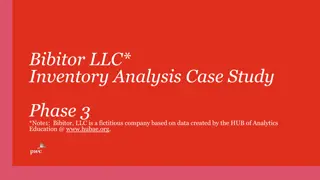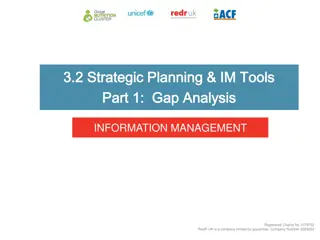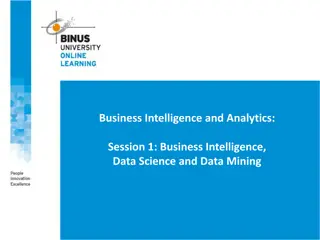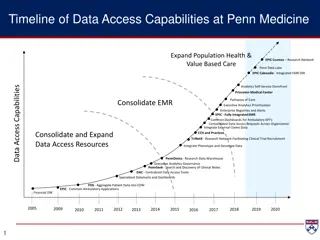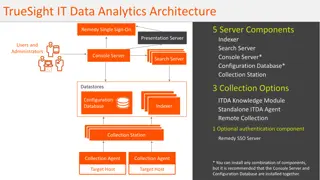
How Data Analytics Tools Can Help You Swap Screen Scrolling for Strategic Analysis
Ditch the drudgery of data delving and embrace strategic success with cutting-edge data analytics tools. This blog explores how transitioning from manual spreadsheet scrutiny to sophisticated analytical tools not only saves time but also elevates you
Download Presentation

Please find below an Image/Link to download the presentation.
The content on the website is provided AS IS for your information and personal use only. It may not be sold, licensed, or shared on other websites without obtaining consent from the author. Download presentation by click this link. If you encounter any issues during the download, it is possible that the publisher has removed the file from their server.
E N D
Presentation Transcript
How Data Analytics Tools Can Help You Swap Screen Scrolling for Strategic Analysis Have you ever found yourself buried under a mountain of spreadsheets, searching for insights like a miner panning for gold? Imagine replacing the endless scroll through columns and rows with strategic decisions driven by clear, actionable data. How much time could you save, and how much more could you achieve? According to a major BI tool provider, even a 20% reduction in manual data entry and analysis could boost a company's productivity by about 30%. This transformation begs the question: why is data analytics important for businesses today?
Data analytics tools are transforming the business landscape, turning raw data into strategic gold. Isn't it time you shifted from manual data trawling to streamlined, insightful analysis? Let's explore how embracing data analytics tools can elevate your business from data-drowned to insight-driven. Common Scenarios of Data Overload Many business users and analysts experience a daily reality where the bulk of their time is not spent analyzing data but rather organizing and searching through it. This excessive scrolling through spreadsheets and databases is more than just a nuisance it is a significant drain on productivity. The typical workflow involves manually extracting data, followed by the arduous task of trying to make sense of vast arrays of numbers and figures without the aid of automation. This manual handling is inefficient and prone to errors, which can detract from the overall quality of the insights gained.
The Toll on Productivity and Decision-Making The impact of data overload extends beyond mere inefficiency. It directly influences the quality of decision-making within companies. disproportionate amounts of time managing data, they have less time to interpret this data and make strategic decisions. According to studies, analysts can spend up to 80% of their time merely preparing data, which drastically reduces the time available for actual analysis. This imbalance highlights why data analytics is important for businesses today it shifts the focus from data management to data utilization. When data analysts spend
Real-time data analytics offer a solution to this challenge by providing tools that automate much of the grunt work involved in data analysis. These tools are designed to handle large volumes of data at high velocity, allowing analysts to engage more deeply with the analysis phase and less with data preparation. For instance, real-time data processing enables businesses to make decisions based on the latest information, not on outdated data that no longer reflects the current market conditions. Key Features of Data Analytics Tools That Enhance Analysis Data analytics tools are indispensable in today's business environment, significantly enhancing the ability to handle vast amounts of data efficiently. Here s an in-depth look at how these tools streamline processes and reduce reliance on manual data exploration, aligning perfectly with the importance of data analytics in business. Automated Data Aggregation and Integration Data analytics tools automate the collection and integration of data from various sources, consolidating disparate data sets into a single, coherent framework. This automation eliminates the time-consuming task of manually gathering and merging data, thereby enhancing data accuracy and availability. Automated integration supports real-time data analytics by ensuring data is consistently up-to-date and accessible, making it a cornerstone for businesses today. Real-Time Data Processing The capability to process data in real-time is a transformative feature for businesses that require immediate insights to make quick decisions. Real-time data analytics tools process information as it comes in, drastically cutting down the time lag between data collection and business insight generation. This immediacy helps businesses stay agile, respond to market changes swiftly, and maintain competitive advantage. Interactive Dashboards and Visualizations Interactive dashboards and visualizations turn complex data sets into understandable and actionable insights. These features allow users to manipulate and explore data in intuitive ways, significantly reducing the need for deep statistical knowledge or extensive data exploration. Dashboards provide a dynamic interface where users can drill down into metrics and trends important to their specific roles, enhancing decision-making across all levels of an organization. Predictive Analytics and Trend Forecasting
Predictive analytics and trend forecasting utilize historical data to identify patterns and predict future outcomes. This aspect of data analytics tools is crucial for strategic planning, risk management, and discovering new opportunities. By forecasting trends, businesses can proactively adjust strategies and optimize operations, thereby underscoring why data analytics is essential for businesses today. Reduction in Manual Data Exploration Together, these features mitigate the need for manual data exploration by providing a suite of tools designed to automate, visualize, and predict data trends effectively. This shift not only saves time but also allows business users and data analysts to focus on higher-value activities, such as strategic analysis and decision-making, which are pivotal in today s data-driven business landscape. How BI Tools Foster a Strategic Mindset Business Intelligence (BI) tools are pivotal in shaping a strategic mindset within organizations, enabling them to tackle business challenges proactively. Here s an in-depth analysis of how BI tools contribute to fostering this essential business approach. Fostering a Proactive, Strategic Approach BI tools empower organizations to move from reactive problem-solving to proactive strategizing. By providing comprehensive data analysis capabilities, these tools help identify patterns, trends, and anomalies, allowing businesses to anticipate issues and opportunities. This proactive approach not only solves problems before they arise but also identifies strategic opportunities that might not be visible without deep data insights. Cultivating a Data-Driven Culture At the heart of a strategic mindset fostered by BI tools is the development of a data-driven culture. This culture prioritizes data in decision-making processes, ensuring decisions are based on evidence rather than intuition. BI tools catalyze this shift by making data accessible and interpretable to all levels of an organization, from executives to front-line employees. This transparency and encourages all employees to base their decisions on data, enhancing the overall strategic alignment of the organization. widespread access to data fosters
Enhancing Resource Allocation, Customer Understanding, and Market Responsiveness Strategic analysis through data analytics tools is crucial for optimizing business operations, enriching customer interactions, and adapting swiftly to market changes. Here s how these tools create significant impacts: Better Resource Allocation Strategic analysis facilitated by BI tools allows businesses to allocate resources more effectively. By analyzing data on operational efficiency, customer behavior, and financial performance, companies can identify areas where resources can be optimized to increase ROI. This kind of targeted allocation minimizes waste and maximizes output, highlighting the importance of data analytics in business for ensuring sustainable growth. BI tools enhance resource allocation by integrating predictive analytics that forecast future trends based on historical data. This technical capability allows businesses to simulate various scenarios and their potential impacts on resources, enabling decision-makers to allocate budgets and manpower with greater precision. For instance, machine learning algorithms can predict seasonal demand fluctuations, helping businesses prepare inventory and staffing levels accordingly. Improved Customer Understanding Data analytics tools provide deep insights into customer preferences, behaviors, and feedback, which are essential for developing personalized marketing strategies and products. This improved understanding helps businesses meet customer needs more precisely, enhancing customer satisfaction and loyalty. Real-time data analytics play a pivotal role here by enabling businesses to adjust their strategies promptly based on the latest customer data.
Improving sophisticated data segmentation and machine learning models that identify customer patterns and preferences. BI tools can dissect large datasets to create detailed customer profiles, which are crucial for development. Techniques such as clustering and classification provide a granular view of customer behaviors, enhancing targeted marketing efforts and boosting customer engagement rates. customer understanding goes beyond basic analytics; it involves personalized marketing and product Enhancing customer understanding directly supports why data analytics is important for businesses today, driving tailored strategies and improved customer engagement. Enhanced Market Responsiveness In the modern-day increasingly swift market environments, the ability to respond quickly to changes can determine a business's success. Strategic analysis through BI tools provides businesses with the agility to adapt to market conditions and consumer trends with speed and precision. By leveraging real-time analytics, companies can anticipate market shifts and react before their competitors, ensuring they remain at the forefront of industry developments. Enhanced market responsiveness is achieved through stream analytics, a feature of modern BI tools that processes data in real time as it flows into the system. This capability allows businesses to react instantaneously to market changes from stock
price fluctuations to social media trendsensuring that the business remains proactive rather than reactive. The technical underpinning of stream analytics involves complex event processing engines and real-time data dashboards that provide ongoing insights into market conditions. Conclusion In a world inundated with data, shifting from tedious screen scrolling to strategic analysis is not just an upgrade it's a transformation. Data analytics tools are everything when making this shift, empowering businesses to harness the true potential of their data swiftly and smartly. With tools like Grow, businesses can leverage advanced analytics capabilities to streamline processes, enhance decision-making, and ultimately drive success. Ready to experience the power of data without the clutter? Start with Grow's 14-day free trial and explore how intuitive and impactful analytics can be. Don't just take our word for it check out the numerous Grow reviews from verified users on Capterra. Dive into the world of Grow and turn your data into decisions today! Original Source: https://bit.ly/3XAcLoT

















